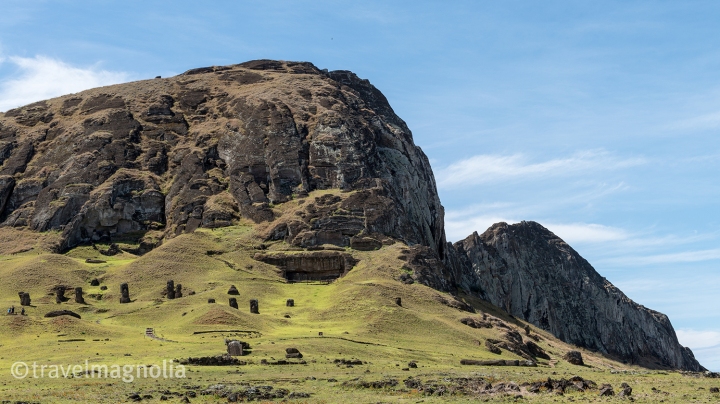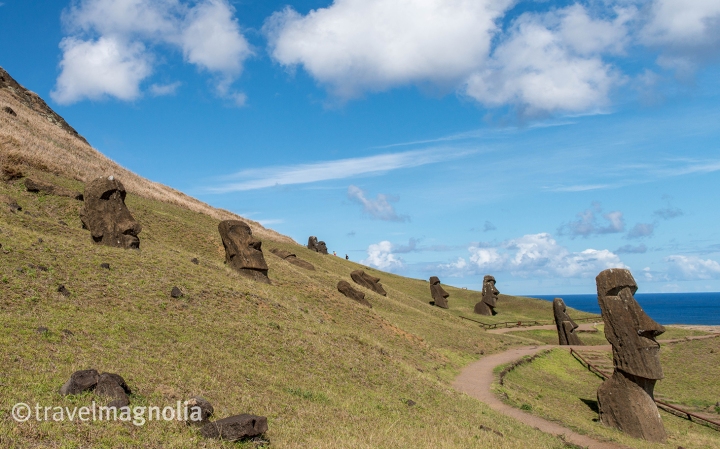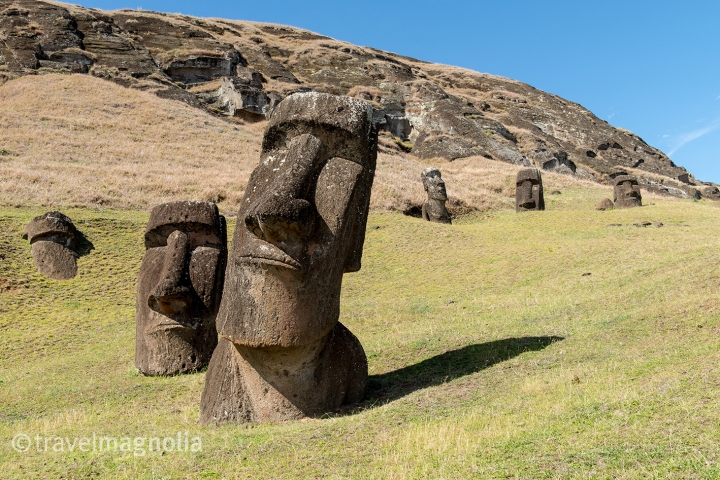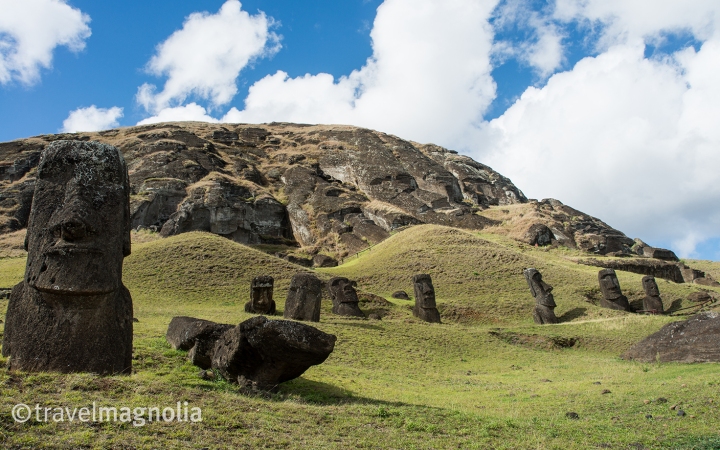
Miles from nowhere – the nearest inhabited land is 1289 miles away – Rapa Nui (also known as Easter Island) is one of the most enchanting and remarkable places I have visited. In the tradition of great things coming in small packages, this 63 square mile triangular-shaped island has enough wonderful sites and activities to warrant spending at least a week. We barely scratched the surface with six full days of hiking, biking and exploring and hope to return one day. The first stop was Rano Raraku, the volcanic crater where every one of the 887 extant monumental statues known as Moai was carved. There are approximately 400 Moai in various locations around Rano Raraku and it is possible to get quite close and look (but not touch)!
There are approximately 400 Moai in various locations around Rano Raraku and it is possible to get quite close and look (but not touch)! The island’s first inhabitants arrived sometime between 700 and 1100 CE. Oral tradition holds that the island was colonized by villagers from another Polynesian island, perhaps one of the Marquesas. Carbon dating shows that the Moai were carved between 1100-1680 CE. Families or tribes would commission a Moai to honor an ancestor who would then protect them.
The island’s first inhabitants arrived sometime between 700 and 1100 CE. Oral tradition holds that the island was colonized by villagers from another Polynesian island, perhaps one of the Marquesas. Carbon dating shows that the Moai were carved between 1100-1680 CE. Families or tribes would commission a Moai to honor an ancestor who would then protect them.  The Moai were carved with stone hand chisels by a team of five or six men and took a year or more to complete. During this time, the commissioning family was responsible for feeding the carvers.
The Moai were carved with stone hand chisels by a team of five or six men and took a year or more to complete. During this time, the commissioning family was responsible for feeding the carvers.  Once the Moai was complete, the family was responsible for moving the statue to its Ahu. Given their size – the largest one raised on a platform weighs 82 tons and is almost 10 meters long – there is a lot of speculation about how they were moved. One theory is they were moved with a Y-shaped sledge (which would have required as many as 250 men to pull). Another possible method was attached ropes and “walking” the Moai. Recently, a group of scientists constructed a modern Moai and demonstrated the feasibility of this latter method.
Once the Moai was complete, the family was responsible for moving the statue to its Ahu. Given their size – the largest one raised on a platform weighs 82 tons and is almost 10 meters long – there is a lot of speculation about how they were moved. One theory is they were moved with a Y-shaped sledge (which would have required as many as 250 men to pull). Another possible method was attached ropes and “walking” the Moai. Recently, a group of scientists constructed a modern Moai and demonstrated the feasibility of this latter method. Approximately half of the statues remain in the quarry. Another quarter were installed on Ahu – shrines or platforms in different locations, and the remainder can be found elsewhere, not having reached their destination. A fallen Moai lost its “mana” or spirit, would no longer be able to protect its family and was abandoned. The family would have to commission a new Moai and begin the lengthy and expensive process again.
Approximately half of the statues remain in the quarry. Another quarter were installed on Ahu – shrines or platforms in different locations, and the remainder can be found elsewhere, not having reached their destination. A fallen Moai lost its “mana” or spirit, would no longer be able to protect its family and was abandoned. The family would have to commission a new Moai and begin the lengthy and expensive process again.

So much more Moai info still to come, including the starring role of Thor Heyerdahl (of Kon Tiki fame) in the next post. Stay tuned!


Dear Maggie,
Happy that I had a small part in your visit to Rapa Nui.
Carolyn
Carolyn Rothberg
Plaza Travel
16530 Ventura Blvd.
Suite 106
Encino, CA 91436
818.990.4053
800 347-4447
818-789-5405 Fax
carolynr@plazatravel.com
Click here to learn how you can skip the lines at the airport – Global Entry Day, March 8th!
[Plaza_email_sig_new_logo_smaller]
Please consider the environment before printing this email and/or any attachments.
LikeLiked by 1 person
Rapa Nui is THE destination I’d like to go to… Massive jealousy!
LikeLiked by 1 person
You must make your way there someday. It is absolutely remarkable.
LikeLiked by 1 person
Oh, amazing! I can’t wait to see more of Rapa Nui… I’ve been fascinated by it ever since I read Thor Heyerdahl’s book “Aku Aku” as a teenager. That crater must be seriously huge though – the Moai look tiny in there!
LikeLike
Your photos of Rapa Nui are so otherworldly. I can only imagine being there was beyond comparison.
LikeLiked by 1 person
Thank you so much! It is an amazing place and likely to remain so given the remote location and limited travel options. That being said, Rapa Nui is well worth the effort.
LikeLiked by 1 person
I have developed an obsession with this wondrous island recently, it’s remoteness and unspoilt beauty is the key to my desire to visit this place. so much so that I have my own. little moai in my car to keep me focused on one day standing on that little island.
LikeLiked by 1 person
So fun that you have a moai in your car!I hope you can get there sooner rather than later, as tourism is increasing which is good and bad news.
LikeLike